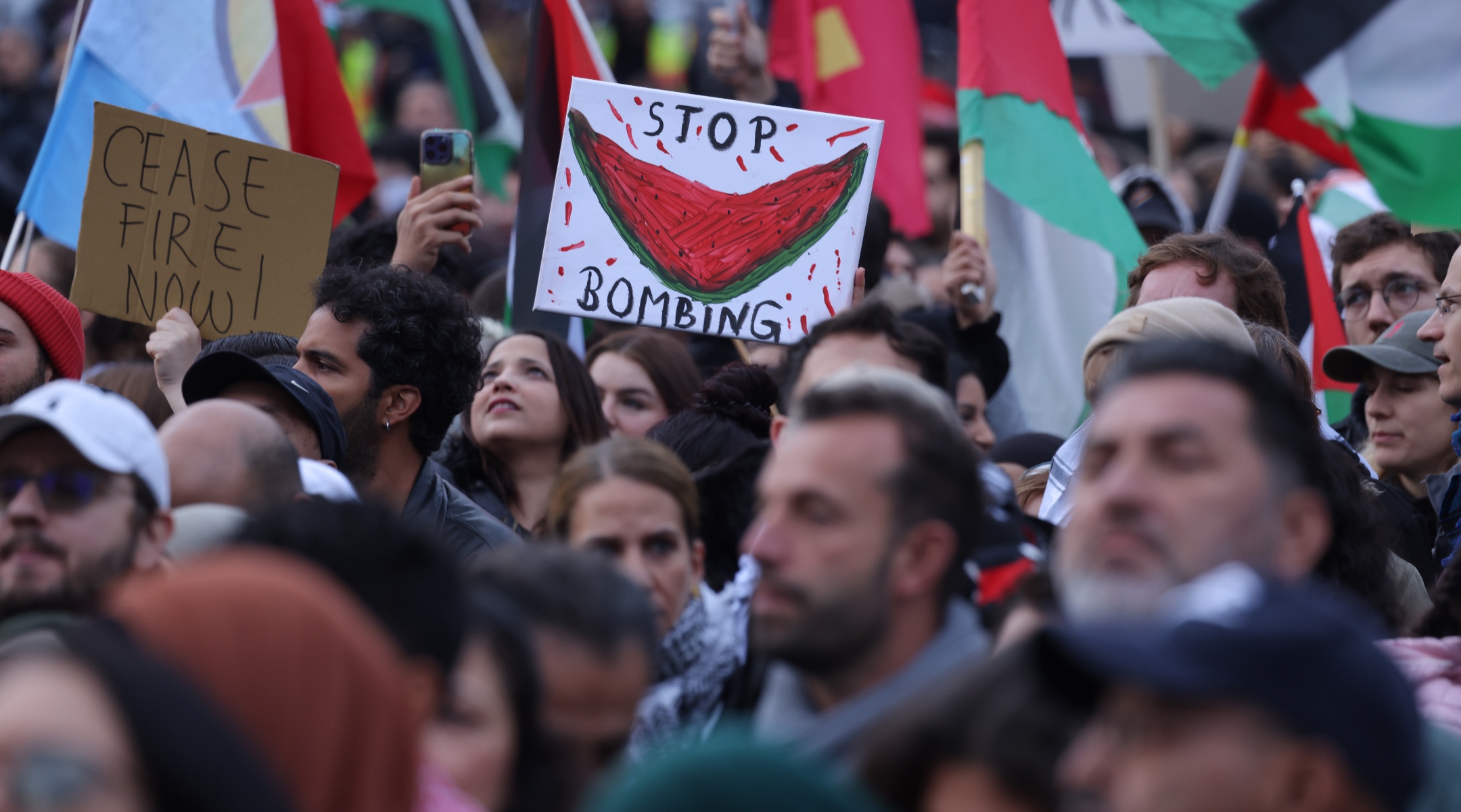How the watermelon wound up on Jennifer Garner’s daughter’s sweatshirt as a symbol of Palestinian nationalism
Watermelons are linked with Palestinian activism because their colors — red, black, white and green — match the colors of the Palestinian flag

People wave Palestinian flags and hold a picture of a watermelon as they gather for a “Global South United” protest to demand freedom for Palestine in Berlin, Oct. 28, 2023. (Sean Gallup/Getty Images)
(JTA) — When the social media watchdog group StopAntisemitism this week posted a photo of Jennifer Garner’s daughter, it called attention to her sweater, which showed a watermelon cut into the shape of a map.
The group took offense at the map — meant to display the shape of Palestine — saying that it “erases the entire country of Israel,” envisioning a Palestinian state in the territory that now encompasses Israel, the West Bank and Gaza.
StopAntisemitism was mocked by many users for raising alarm over a picture of fruit. But the sweater featured one of many graphics that have established watermelons as a symbol of Palestinian nationalism that dates back decades and has seen a resurgence during Israel’s ongoing war with Hamas in Gaza.
Watermelons are linked with Palestinian activism because their colors — red, black, white and green — match the colors of the Palestinian flag. That symbol became widespread during the decades when Israel banned the waving of the Palestinian flag in Gaza and the West Bank. In lieu of the banner, Palestinians would use pictures of watermelons “as a metaphor for the Palestinian flag and to circumvent the ban,” prominent Palestinian artist Khaled Hourani, who was in his 20s when the first intifada began in 1987, told the Washington Post in 2021.
“The watermelon, which was a common crop in the region, became a symbol of political opposition,” reads a recent blog post from Beeri Printing Press, a prestigious Israeli imprint located on Kibbutz Beeri, the site of a massacre by Hamas on Oct. 7. “And so, in place of Palestinian flags, in Gaza and the [West] Bank they drew graffiti and made the watermelon an artistic expression. Where there were no flags, there would be watermelons.”
In the 1980s, Sliman Mansour, a Palestinian artist, reportedly had an exhibition shut down by the Israeli military because the works featured the colors of the Palestinian flag. Mansour has recalled in subsequent years that the officer told him even a picture of a watermelon would be illegal. According to the New York Times, Mansour included a painting of a watermelon in a 1987 book of Palestinian folk tales.
Israel allowed the display of the Palestinian flag after the Oslo peace accords in 1993, and contentions over their display receded. But the symbol experienced a revival earlier last year, before the war broke out, when Itamar Ben-Gvir, Israel’s far right minister of national security, attempted to ban public displays of the Palestinian flag as the country was being convulsed with protests against far-reaching judicial reforms proposed by the government.
In June, the Israeli activist group Zazim purchased advertisements on shared taxis in Tel Aviv that displayed a watermelon alongside the text “This is not a Palestinian flag.”
Watermelon depictions have proliferated since the outbreak of the Israel-Hamas war on Oct. 7, and the watermelon emoji has become a signifier of pro-Palestinian sympathies on social media over the last three months. The symbol has in turn sparked controversy for its offensive meaning in another context.
The New York chapter of the Democratic Socialists of America used it on a poster to call out the pro-Israel position of U.S. Rep. Hakeem Jeffries, the New York Democrat who is the minority leader in the U.S. House of Representatives.
“Hakeem Jeffries’ constituents demand ceasefire now!” said the poster, with a depiction of a huge watermelon slice, calling for a Nov. 17 rally.
That backfired: The fruit is seen as a bigoted reference to Black Americans, something Jeffries’ spokesman seized upon.
“The watermelon has long been deployed as a dehumanizing racist trope by white supremacists in America,” Andy Eicher told the New York Post. “In connection with the planned rally targeting our district office, the use of racially inflammatory imagery should come as no surprise given the role NYC-DSA and other gentrifiers have played in aggressively attacking Black elected officials.”
This article originally appeared on JTA.org.

















